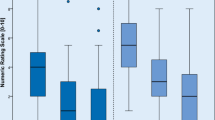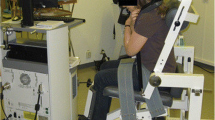Abstract
Psychological factors are assumed to play a major role in pain-related work disability. Assessment of pain-related disability using a functional capacity evaluation, usually includes assessment of trunk strength and range of motion. Isokinetic strength testing is a method used to measure strength and function of isolated muscles and has been reported to be an objective, quantifiable assessment of trunk function. Given that psychological factors are purported to play a role in pain-related disability, it would be important to assess their influence on measurement of physical function. The present study was conducted to assess the influence of psychological variables on isokinetic trunk strength performance. One hundred and eighty-six consecutive male outpatients referred to a work-rehabilitation center were given a functional capacity evaluation. All patients had been out of work for at least 3 months with the chief complaint of low back pain. The evaluation included isokinetic trunk strength testing and measurement of psychological variables (pain levels, distress, pain coping, pain behavior, somatization, expectation to return to work) that have been known to contribute to pain-related disability. Data analyses revealed significant correlations among psychological variables and measures of trunk strength and function. The findings provide support for a relationship between psychological variables and isokinetic strength testing performance.
Similar content being viewed by others
References
Mayer TG, Gatchel RJ.Functional restoration for spinal disorders: The sports medicine approach. Philadelphia, PA: Lea and Febiger, 1988.
Mayer TG, Gatchel RJ, Kishino W. Objective assessment of spine function following industrial injury: A prospective study with comparison group and one-year follow-up.Spine 1985; 10: 482–493.
Hazard RG, Fenwick JW, Kalisch SM. Functional restoration with behavioral support: A one-year prospective study of patients with chronic low-back pain.Spine 1989; 14: 157–161.
Mayer TG, Gatchel RJ, Mayer, H, Kishino WD, Keeley J, Mooney V. A prospective two-year study of functional restoration in industrial low back injury.JAMA 1987; 258: 1763–1767.
Mayer TG, Gatchel RJ, Kishino, W. A prospective short-term study of chronic low back pain patients utilizing novel objective functional measurement.Pain 1986; 25: 53–68.
Hislop HJ, Perrine JJ. The isokinetic concept of exercise.Phys Ther 1967; 47: 114–117.
Langrana NA, Lee CK. Isokinetic evaluation of trunk muscles.Spine 1984; 9: 171–175.
Feuerstein M, Papciak AS, Hoon PE. Biobehavioral mechanisms chronic low back pain.Clin Psych Rev 1987; 7: 243–273.
Fordyce W, Shelton J, Dundore D. The modification of avoidance learning pain behaviors.J Behav Med 1982; 4: 405–414.
Lethem J, Slade PD, Troup JDG, Bentley G. Outline of a fear-avoidance model of exaggerated pain perception-I.Behav Res Ther 1983; 21: 401–408.
Rosensteil AK, Keefe FJ. The use of coping strategies in chronic low back pain patients: Relationship to patient characteristics and current adjustment.Pain 1983; 17: 33–44.
Turner JA, Clancy S. Strategies for coping with chronic low back pain: Relationship to pain and disability.Pain 1986; 24: 355–364.
Romano JM, Turner JA. Chronic pain and depression: Does the evidence support a relationship?Psychol Bull 1985; 97: 18–34.
Svensson H, Vedin A, Wilhelmsson C, Andersson GBJ. Low back pain in relation to other diseases and cardiovascular risk factors.Spine 1983; 8: 277–285.
Swartz M, Hughes D, Blazer D, George L. Somatization disorder in the community: A study of diagnostic concordance among the diagnostic systems.J Nerv Ment Dis 1987; 175: 26–33.
Taylor J. The effects of personal and competitive self-efficacy and differential outcome feedback on subsequent self-efficacy and performance.Cog Ther Res 1989; 13: 67–79.
Dolce JJ, Crocker MF, Moletheire C, Doleys DM. Exercise quotas, anticipatory concern and self-efficacy expectancies in chronic pain: A preliminary report.Pain 1986; 24: 365–372.
Feuerstein M, Papciak AS.Work reentry questionnaire. Unpublished manuscript, 1989.
Millon T.Millon clinical multiaxial inventory manual (3rd Ed.). Minneapolis: National Computer Systems, 1983.
Feuerstein M, Greenwald M, Gamache MP, Papciak AS, Cook EW. The pain behavior scale: Modification and validation for outpatient use.J Psychopath Behav Assess 1985; 7: 301–315.
Loredan Biomedical.Lido active isokinetic rehabilitation system operations manual. Davis, CA: Loredan Biomedical, 1988.
Papciak AS, Feuerstein M, Jones RH. Influence of perception of disability on performance in a functional capacity evaluation in low back pain patients. Abstract presented at the Society of Behavioral Medicine, Washington, D.C., March 20–23, 1991.
Sandstrom J, Esbjornsson E. Return to work after rehabilitation: The significance of the patient's own prediction.Scand J Rehab Med 1986; 18: 29–33.
Author information
Authors and Affiliations
Rights and permissions
About this article
Cite this article
Papciak, A.S., Feuerstein, M. Psychological factors affecting isokinetic trunk strength testing in patients with work-related chronic low back pain. J Occup Rehab 1, 95–104 (1991). https://doi.org/10.1007/BF01073380
Issue Date:
DOI: https://doi.org/10.1007/BF01073380




